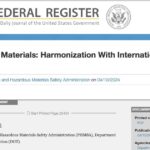When you hear about illegal border crossings, you probably don’t think about hazardous materials — but you should. New research shows that an alarming amount of dangerous chemicals are illegally transported, despite strict rules regarding their movement.
According to Science Daily, researchers from China and Switzerland analyzed public trade data from the United Nations Comtrade database for 46 of the 54 listed chemicals. A total of 64.5 million tons were traded globally from 2004 to 2019. Of these, 27.5 million tons were traded illegally — exported to countries that had explicitly refused to import them. The study was published July 10 in Nature Sustainability.
The rules regarding which chemicals countries were refusing to accept were set out in the 2004 Rotterdam Convention. Some of the chemicals on this list include mercury compounds, pesticides and five types of asbestos. Noncompliance is a worldwide problem, the study found.
“This prevalent illegal trade is highly concerning because it undermines global efforts to protect us and our environment from hazardous chemicals,” says Empa researcher Zhanyun Wang, who initiated the study.
Also Read: Feds Report on WMD Office Effectiveness
Wang and his co-authors say the actual figures are probably considerably higher because things like smuggling and black markets were not includes in the analysis. And some countries, like the U.S., for example, never ratified the Rotterdam Convention and are subject to different rules.
Of the total 64.5 million tons, 55.3 million tons is ethylene dichloride, a carcinogenic and organ-damaging solvent used to produce polyvinyl chloride (PVC). The toxic reagent, disinfectant and pesticide ethylene dioxide come in second at 6.3 million tons. The other chemicals, mostly pesticides, make up a small portion of the total.
“But we see that these highly toxic compounds are still being traded in significant quantities,” Wang says. “Since the Rotterdam Convention came into force, trade has decreased only slightly. Yet for many of these substances, we’ve known for decades how harmful they are.”
The authors also discovered a brisk trade in some substances that have been severely restricted or even banned for decades. These include the legacy toxic pesticides aldrin, chlordane, heptachlor and dieldrin, which have been banned worldwide as the “Dirty Dozen” under the Stockholm Convention since 2004.
The Rotterdam Convention has only had a compliance committee to monitor and address its implementation since 2020. “We are hopeful that this, together with national efforts on reducing the production and use of highly hazardous chemicals, will greatly reduce illegal trade in the future,” Wang says.
Original post – Copyright © 2023 HazmatNation.com. Externally linked references may hold their own independent copyright not assumed by HazmatNation











